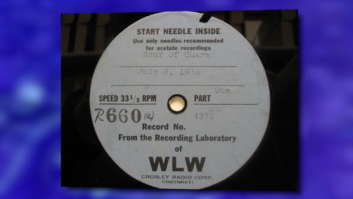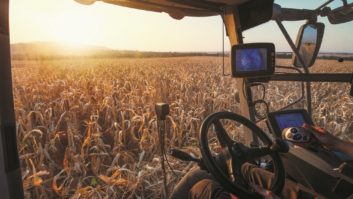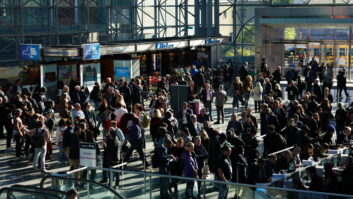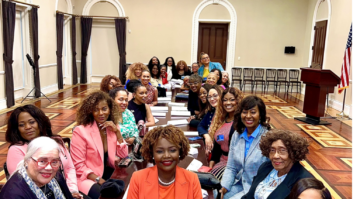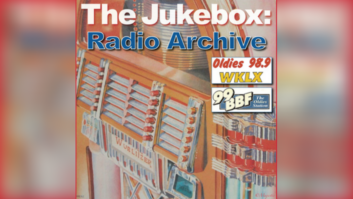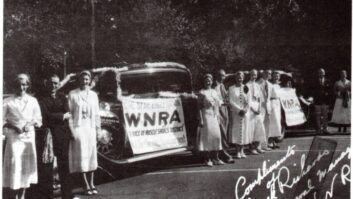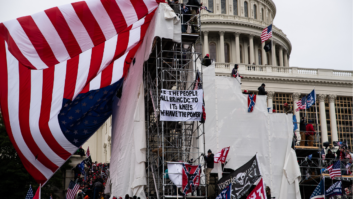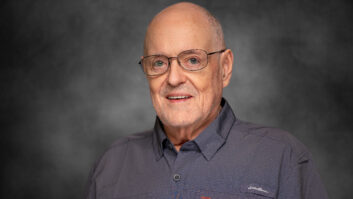Editor Paul McLane writes: I told you in my Nov. 5, 2014, column about the work of the Radio Preservation Task Force; you can read that story, including the comments of Christopher Sterling and Josh Shepperd, at radioworld.com/preservation. Here, veteran broadcaster Donald Angelo takes up that challenge.
We all agree that the written word of 2,000 years ago, preserved and translated countless times, is of priceless value today. It gives us a glimpse into who we were, how we lived and what we thought.
Imagine if an audio recording device had existed then.

I’ve known several people from early in my career who actually worked in radio in the beginning years of the early 1920s. I am planning some recording sessions with a few who are still with us. Their firsthand stories are amazing. It’s interesting to note that we are only the second and third generations away from the day KDKA went on the air and the actual historical beginnings of the electronic age of broadcast communications when Marconi brought the world together.
Paul McLane was absolutely correct to ask in his earlier column, “Where do you start a job this big? It sounds monumental.” However, I disagree with Josh Shepperd’s call to cut the search off at 1925–1975.
I submit that we must focus on preserving and documenting from 1922 to 1999. The recorded history of broadcasting in the 20th century actually documents the medium’s very beginning and virtual end as we know it today. Its evolution into what it is becoming now is beginning to have no relation at all to what my generation experienced while working in radio in its first century.
If we start this monumental job today, imagine what a great service we’ll have done for civilization 2,000 years from now. How exciting it would be for them to actually see and listen to who we were, how we lived and what we thought.
LET’S GET STARTED
First, we need a national underwriter who can supply the funding to do the job right. They should receive naming or branding rights.
Next, we must create a central storage depository and quickly collect what has survived. Then, begin the massive long-term job of cataloging, restoring, preserving, digitizing and then promoting and sharing the content.
You will find that local radio stations are not a good source for cooperation, information or material. The outlets we have today are all in big trouble because of a lack of product, along with the lack of funding to buy or produce quality programming fast enough to satisfy the appetite of the American public.
It would be a great service to make this vast untapped supply of historical programming available to station owners, programmers of traditional media and also to the various new-tech outlets that are now delivering information and entertainment to a new generation of viewers and listeners who would benefit by learning from past broadcast history.
This would be of important educational value to the youth of tomorrow who have never heard of Guglielmo Marconi, Lowell Thomas, William B. Williams, Casey Kasem, Wolfman Jack, George “Hound Dog” Lorenz, Joey Reynolds, Dick Biondi and so many more, plus hundreds of outstanding small-market broadcasters whose talent and gifted abilities have always equaled that of anyone in New York, Chicago and L.A.
Deregulation in 1979 changed the landscape forever. For the first 57 years, broadcast stations were owned and operated by broadcasters serving their communities. The 1980s and ’90s saw such a flurry of buying and selling with price multiples increasing at such staggering rates that even some large media corporations could not serve the debt. This forced an end to independent ownership.
The only way to survive was through massive consolidation. Groups owning hundreds of stations, downsizing staffs, ending local programming in exchange for cheap syndicated programming to cut overhead. This stunted creativity and ended community service and has resulted in the vanilla media we have today.
Every time a station was sold and new management came in, a dumpster arrived at the back door and decades of valuable archives were tossed and lost. “We’re downsizing and moving the studios to rental space in a local office building” — this has become a familiar memo.
BBA’s MISSION
Our Buffalo Broadcasters Association was formed 20 years ago with part of its mission dedicated to rescuing and salvaging broadcast memorabilia from stations and personal collections that includes thousands of reels of tape from quarter inch audio up to 2-inch video.
In addition, the BBA has the entire 16 mm film library of all the Buffalo TV stations, which represents all the news footage shot from the late ’50s through the ’70s — a virtual history of people, places and events in Buffalo during those decades.
Today, the BBA has a 4,000-square-foot storage/resource facility full of wonderful broadcast artifacts, equipment, recordings and memorabilia covering the 20th century from 1922 — from Buffalo’s Fran Striker, who gave us the Lone Ranger; to Buffalo Bob Smith, who gave us Howdy Doody; along with Buffalo’s Foster Brooks, to Mark Russell, Randy Michaels, Wolf Blitzer and Tim Russert.
Dave May, a retired Buffalo Broadcaster and Hall of Fame inductee, is curator of our storage/resource facility in Buffalo. He leads a group of volunteers who spend several hours each week sorting, cleaning, cataloging and inputting into a database all of this vast collection. This is in preparation for the day when the BBA completes its mission of establishing The Buffalo-Niagara Hall of Fame interactive museum complex, hopefully to be built near Buffalo’s Erie Canal waterfront tribute development project now under construction.
It is a tragedy how much has been lost. However, there is hope in the fact that there are several organized broadcaster clubs and organizations around the country that have worked hard in a mission similar to the BBA to rescue and store these priceless artifacts. We must bring all these groups together.
The Radio Preservation Task Force has billed itself as the first national radio history project of the Library of Congress. Our new BBA President Heidi Raphael, who is on the board of the Library of American Broadcasting, is also willing to help. I urge the task force to identify, contact and organize all these broadcast clubs and organizations in an effort to open a dialogue that takes advantage of the knowledge and resources that would make this monumental job easier to manage. We are all here and willing to help.
Chris Sterling’s suggestion to conduct a one- or two-day conference in D.C. would be an excellent starting point. It should also be possible to identify all the interested players and to have an online dialogue throughout the year with all interested parties before the event takes place. Let’s begin!
Donald Angelo, chairman emeritus of the Buffalo Broadcasters Association, is a 50-year veteran radio and TV broadcaster with experience on-air, off-air and in management and ownership in several markets. He is a Hall of Fame inductee, founding member and past president of the BBA.
Comment to [email protected].





